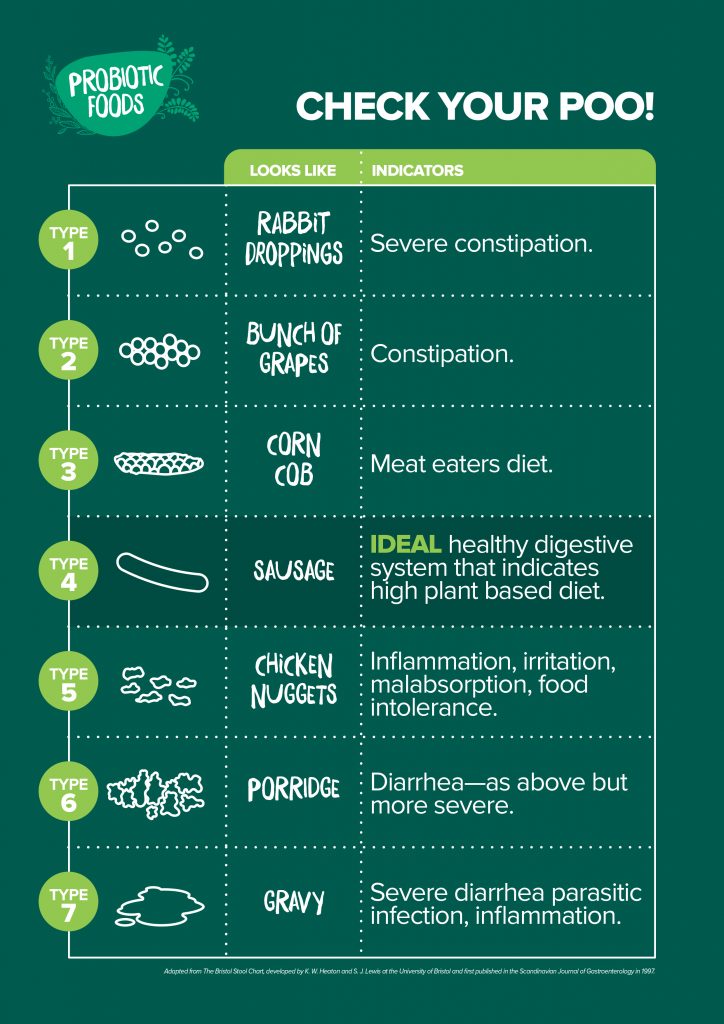Our grandmothers did it, Dr Oz talks about it and colonic hydrotherapists do it. They talk about and check poo and everyone should too! Let’s not be squeamish about our normal daily or hopefully twice daily bowel movement. Checking the colour, shape and consistency of stool, whether it floats or sinks can be lifesaving for your customers.
Encouraging customers to check their stool can help unravel some of the mysteries and diseases of the gut—constipation, diarrhea, diverticulitis, inflammatory bowel disease and colon cancer. It can also be confirmation that their gut is in good shape.

What’s poo made of?
Not what you think it is. Faeces are three quarters water. The water content makes our faces soft and easy to pass and enables metabolic waste products like excess cholesterol, hormones, toxic chemicals from medication and food to be safely transported out of the body.
A third of the solid component is bacteria that have done their job and ready to retire. That’s why you need to keep replacing them. One third is indigestible food fibres and the final third is cholesterol, and toxic chemicals. That’s why constipation can be so harmful to the body because toxins are just reabsorbed back into the bloodstream and the liver, the very wastes your body wants to remove.
Transit time, the time it takes for food to be fully digested and pass from mouth to toilet is anywhere from 12-24 hours. Test this by eating some beetroot and count the number of hours it takes for stool to turn red. Longer than 24 hours and you need to read on.
Colour
Normal poo is brown to yellowish brown. That’s due to the red pigment of old blood cells that is converted by the liver and finally by gut bacteria to brown.
Black to red
Unless you have been eating beetroot, the colour red and signs of fresh blood in your poo can indicate hemorrhoids or something more sinister. Congealed blood is black and indicates bleeding further up the digestive system or excess iron supplements. The presence of blood in the stool urgently needs to be checked by your doctor.
Light brown to yellow
Less red pigment from the breakdown of red blood cells has made it’s way into the gut. There could be a problem with your gut bacteria. Are you taking antibiotics or have diarrhea? Gilbert’s syndrome also creates this colour of poo.
Light brown to grey
Have poo tested by your doctor as this colour can indicate a problem with the connection between the liver and the gut.
Green
Green stool can occur when food moves too quickly through the intestines and bile doesn’t have a chance to be broken down. It needs to be checked out. Green can also be a sign of antibiotic use, lots of leafy greens, green juices and powdered greens or iron therapy.
Shape and consistency
Although mothers and grandmothers have had the guts to check poo for centuries, the Bristol Stool Chart was only developed in 1997 by a man, Dr KW Heaton. It’s a useful guide and medical aid and we have expanded on it here.
If you have Type 1 constipation you might have four plus days between bowel movements. On the other end of the scale Type 7 diarrhea has a transit time of 10 hours or less indicating inflammation and infection.
Sinkers and floaters
For those in the happily pooping category of Type 4 and 5, check to see whether your stool plummets to the bottom of the toilet bowl. This indicates undigested food and nutrients and there are benefits from taking probiotics, addressing gastric acid levels and digestive enzymes.
Stool that sinks slowly contains bubbles of gas produced by gut bacteria. Congratulations your Probiotic Foods are working well!
References
Adapted from The Bristol Stool Chart, developed by K W Heaton and S J Lewis at the University of Bristol and first published in the Scandinavian Journal of Gastroenterology in 1997.
Enders, G 2016, Gut: The inside story of our body’s most underrated organ
www.doctoroz.com/article/what-your-stool-telling-you
Medical disclaimer: This blog provides general information and discussion about gut health and related subjects. Whilst every effort is made to present up to date information, the area of gut health and the microbiome are changing constantly. We welcome any comments or suggestions. By reading this blog, you agree not to use this blog as a substitute for medical advice to treat any medical condition in either yourself or others. The author encourages you to consult a health professional before making any health changes, especially any changes related to a specific diagnosis or condition. No information contained in these pages should be relied upon to determine diet, make a medical diagnosis, or determine treatment for a medical condition. The information is not intended to replace a one-on-one relationship with a qualified healthcare professional and is not intended as medical advice. Links to other (“third party”) web sites are provided to you to expand understanding of the subject and are not an endorsement or recommendation by the author for the services, information, opinion or any other content on the site or as an indication of any affiliation, sponsorship or endorsement of such third party web sites. Your use of other websites is subject to the terms of use for such sites. By reading this blog, you agree that you are responsible for your own health decisions. NO information contained in this blog should be used to diagnose, treat, prevent or cure any disease or condition.The contents of these blogs are copyright and available to wholesale partners for free. We encourage you to share with your team and customers on the basis that “Probiotic Foods Australia” is the acknowledged author within the actual media that the blog is reproduced.

